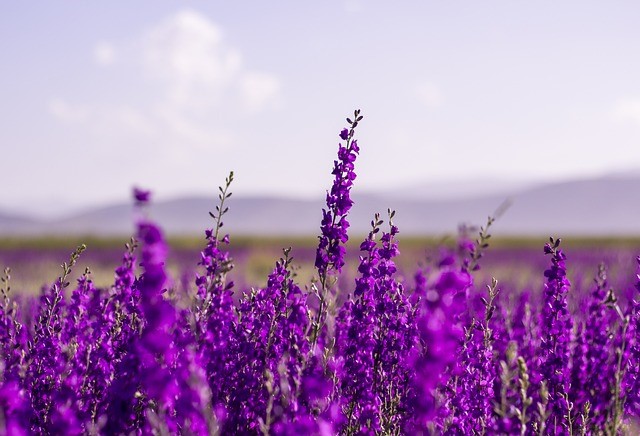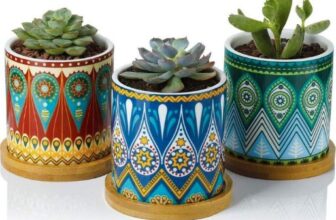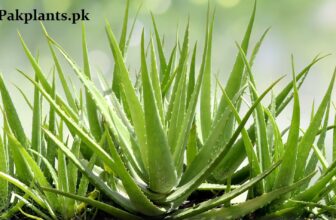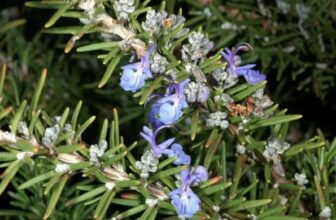Pitcher Plant
Pitcher plants also known Dumbwatches, Carnivorous, Insectivorous,Venus fly trap, Nepenthe.These as are insectivorous plants that thrive in nitrogen-deprived soil, characterized by their unique, hollow leaf structures resembling jugs or pitchers. These specialized leaves serve as traps for prey, attracting and ensnaring various insects. The name “pitcher plants” derives from their distinctive shape and form.
These pitcher shaped leaves have evolved specialized traps to capture prey, predominantly insects, addressing their need for nitrogenous proteins. Their carnivorous nature is evident as they entice and ensnare invertebrates using nectar-secreting pitchers. Hence, pitcher plants are categorized as carnivorous plants but also known as insectivorous plants.
Larger pitcher plants may even capture larger prey such as rats or frogs, expanding their predatory capabilities. Within the realm of carnivorous plants, these modified leaves serve as perilous traps. Many carnivorous plants have developed distinctive mechanisms to capture their prey, and pitcher plants are no exception.Some species also make use of leaf litter or animal feces to supplement their nutrition.
A commonly used term for pitcher plants is “dumbwatches.” This nickname originates from their unique flowers, characterized by an umbrella-shaped style that is often compared to a clock lacking hands.
Around 600 species of carnivorous plants fall under six distinct angiosperm subclasses, encompassing both monocots and dicots. These carnivorous plant species primarily belong to the Nepenthes and Sarracenia genera.
Physical Description
The parts of the pitcher plant are
- Flowers.
- Rhizomes with roots,
- Carnivorous leaves(pitchers)
Most species are easily recognized by their large vertical open-mouthed pitchers that can be as much as 3 feet tall.
- Flowers: The petals of the flower typically display hues of red, yellow, or occasionally pink, blossoming during the spring season. As they mature, these flowers transform into five-chambered fruits capable of containing over a hundred seeds.
Flowers are small, five-petaled white or pinkish that are borne on one side of a curving stem that can attain the hieght of 10 to 25 cm.
- Roots/Rhizomes leaves, and flowers emerge from the end of a rhizome, which has a remarkably long lifespan spanning decades. Roots exhibit a have resistance to flood and fire. The fleshy roots absorbs essential water and micronutrients.
- The pitchers, which are modified leaves capable of photosynthesis, serve the function of capturing and digesting prey. These pitchers exhibit two distinct presentations: horizontal and vertical.
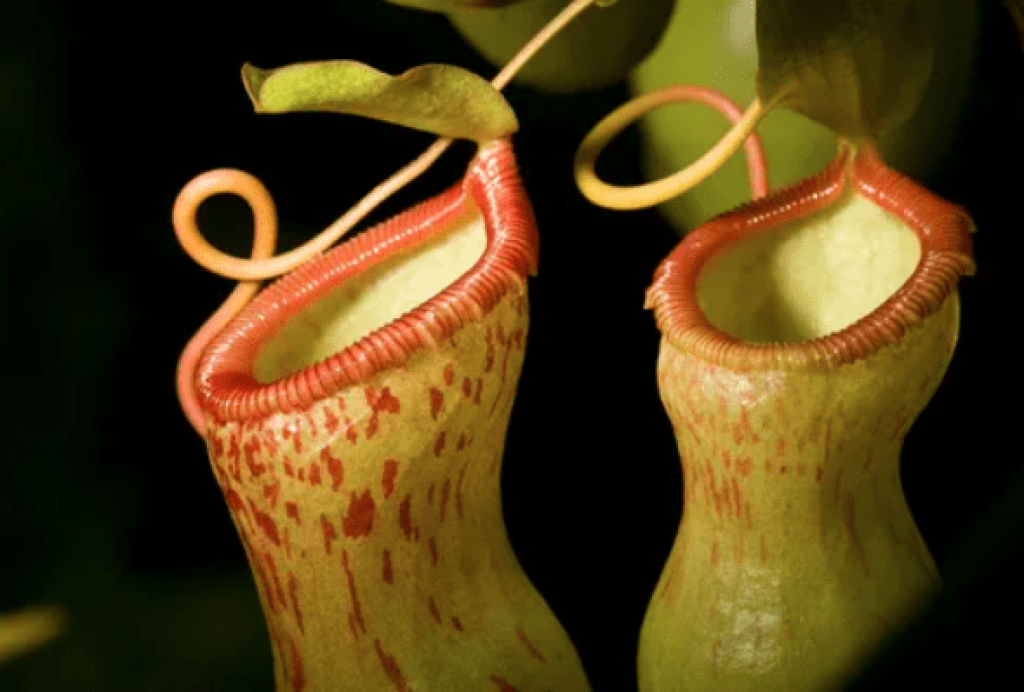
Trichome: Covering the upper surface of these pitchers are flexible gland-tipped trichomes, or plant hairs, that release a sticky substance, attracting and ensnaring insects and other small creatures. Once trapped, the prey becomes entangled in the sticky glands, resembling tentacles. Sensitive tentacles, topped with red mucilage-secreting glands, fold over to secure and begin the process of digesting the struggling insect. After digestion, the leaf unfurls to reset the trap for future prey.
Trap: The nectar is secreted from the underside of the trap’s lid. This attract the prey to approach, causing them to slip from the mouth of the pitcher into a liquid pool at the base. Escape becomes impossible due to the downward-pointing hairs and smooth sides of the pitcher. As a result, the trapped animals drown and are broken down by enzymes for digestion.
Carnivorous plants typically undergo photosynthesis at considerably lower rates compared to non-carnivorous plants. Therefore, the second condition conducive to the evolution of carnivory in plants is an abundance of sunlight. The waterlogged habitats where carnivorous plants reside are saturated with sunlight, enabling even those plants that are inefficient in photosynthesis to flourish, as long as they acquire the essential nutrients they lack.
Types of Traps
The trapping method has evolved separately in carnivorous plants on several different continents – North America, South America; tropical South-East Asia, Australia.
There are 5 varieties of trapping devices employed by these crafty plants.
1-Snap Trap
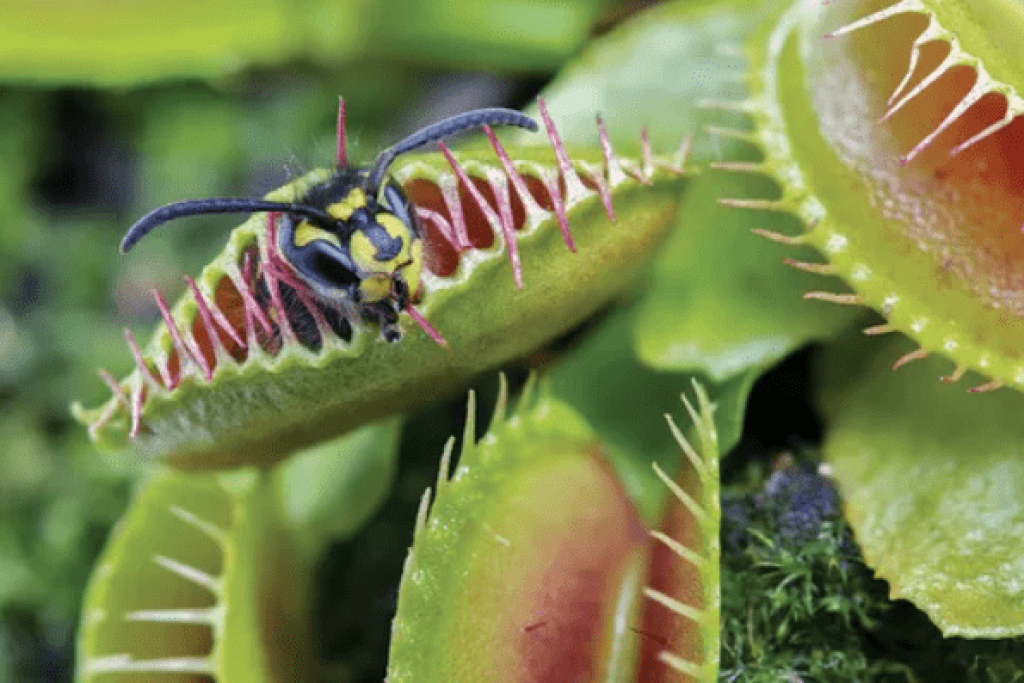
Venus Flytrap is most famous and sophisticated mechanisms among carnivorous plants. Within the trap’s mouth, there exist sensitive hairs that detect the movements of potential prey. Upon detection, these hairs trigger a rapid closure of the trap, ensnaring the prey within a fraction of a second.
2-Pit Fall

These plants create a vessel that have vibrant colors or sweet nectar and filled with digestive enzymes that entice prey to fall inside. It also has slippery surface that contain a sticky trap in it. It wait the prey to fall in and then creating a challenging environment for the captured prey to climb back out. Prey drowns in it and undergoes digestion.
These traps, commonly referred to as ‘pitchers,’. Their shapes vary widely, resembling from champagne flutes to water balloons.
While insects make up the majority of the caught prey, larger pitchers can occasionally ensnare reptiles and even small mammals.
3-Flypaper
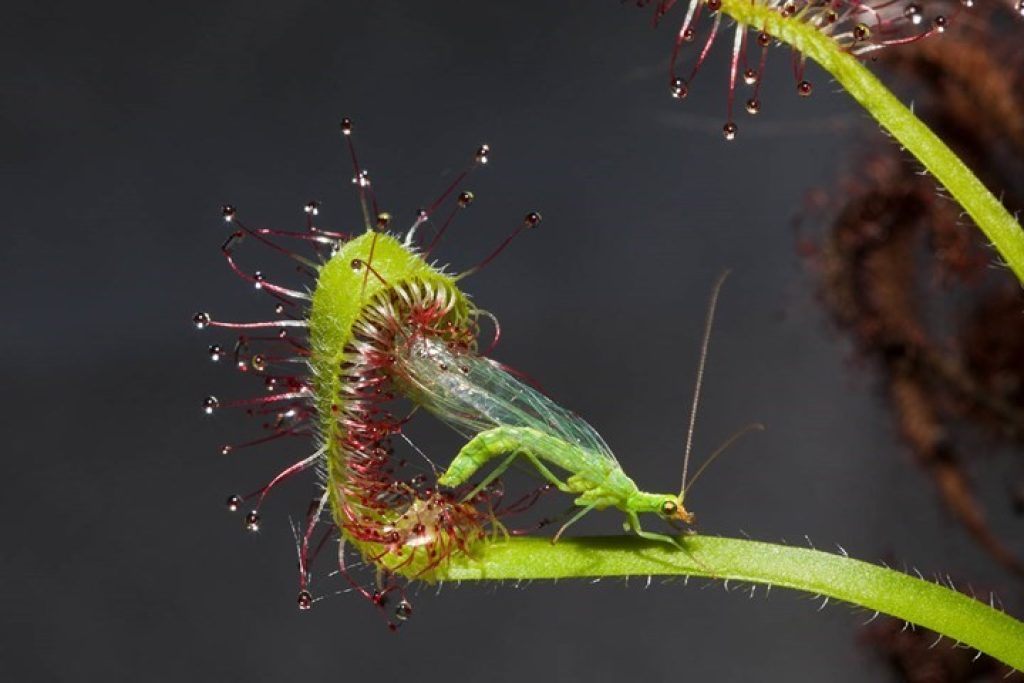
Flypaper traps represent another favored mechanism among insect-hungry plants. These plants possess glands on their leaves that secrete adhesive substances, which serve as the essential glue for trapping insects, along with digestive enzymes. Certain variations, such as sundews, have the ability to manipulate their sticky tentacles, ensuring a more complete envelopment of their captured prey.
4-Bladderworts
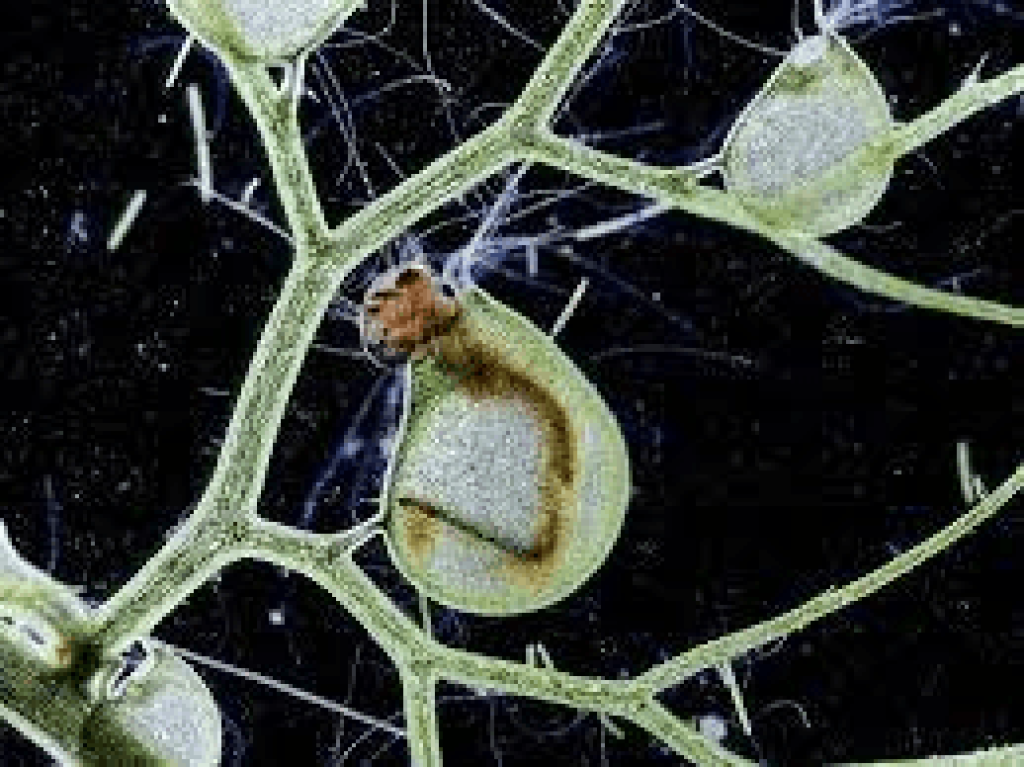
The fava bean-shaped bladders within this mechanism expel water, generating a vacuum effect. Upon detecting an insect, a trap door swiftly pulls inward, drawing everything within its and shut. The captured prey undergoes digestion while the water is expelled back out, creating another vacuum, ready to ensnare the next unsuspecting victim.
5-Corkscrew
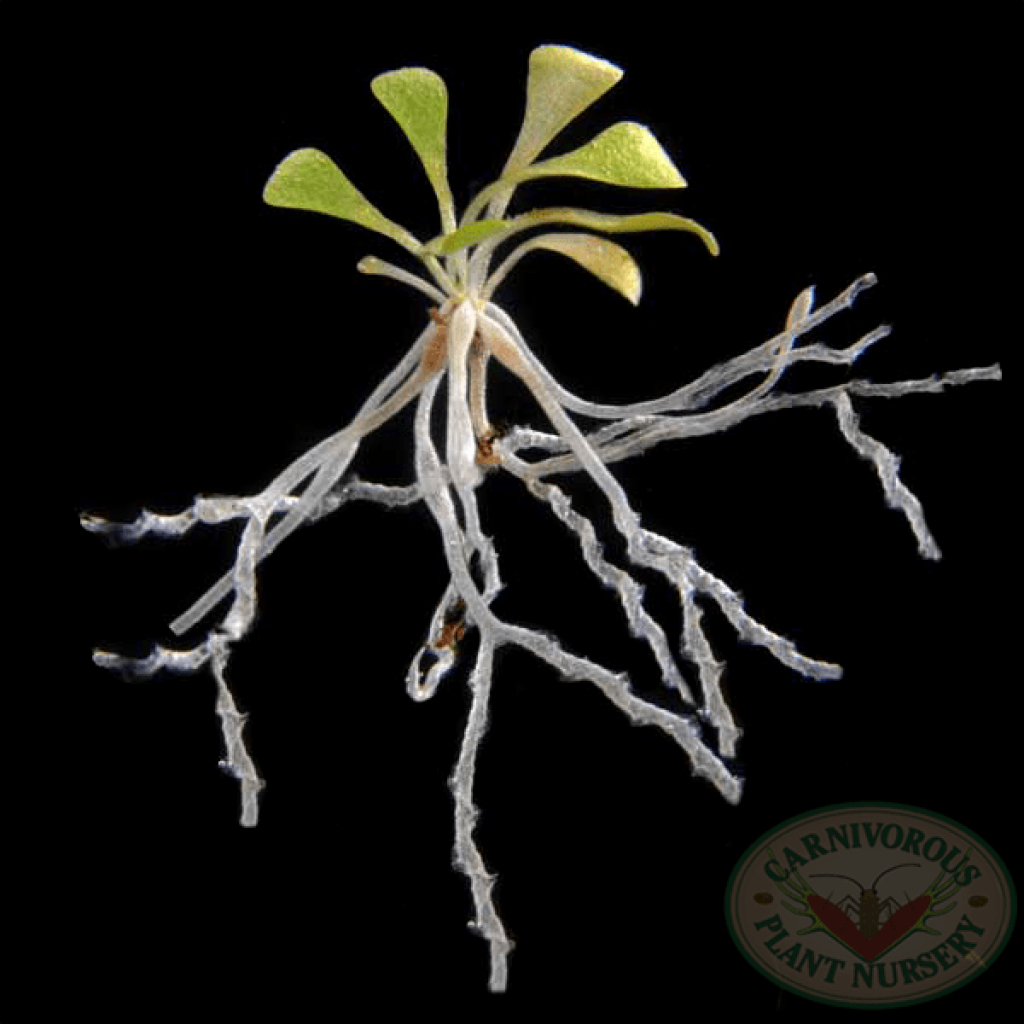
The foliage above ground on these plants develops root-like subterranean tunnels. Insects wander into these tunnels, trapped and die. The inward-facing hairs within these tunnels act as a barrier, preventing the insects from retracing their steps and exiting the way they entered. Consequently, they are unable to escape.
Fragrance
Pitcher plants possess a lesser-known feature— a subtle yet captivating fragrance. The nectar-secreting glands situated along the rim release scents that attract insects. This shows t plant’s remarkable adaptation to attracting prey.
Some Famous Species of pitcher plant
Nepenthes (Tropical Pitcher Plants)
1-The Hooded Pitcher Plant
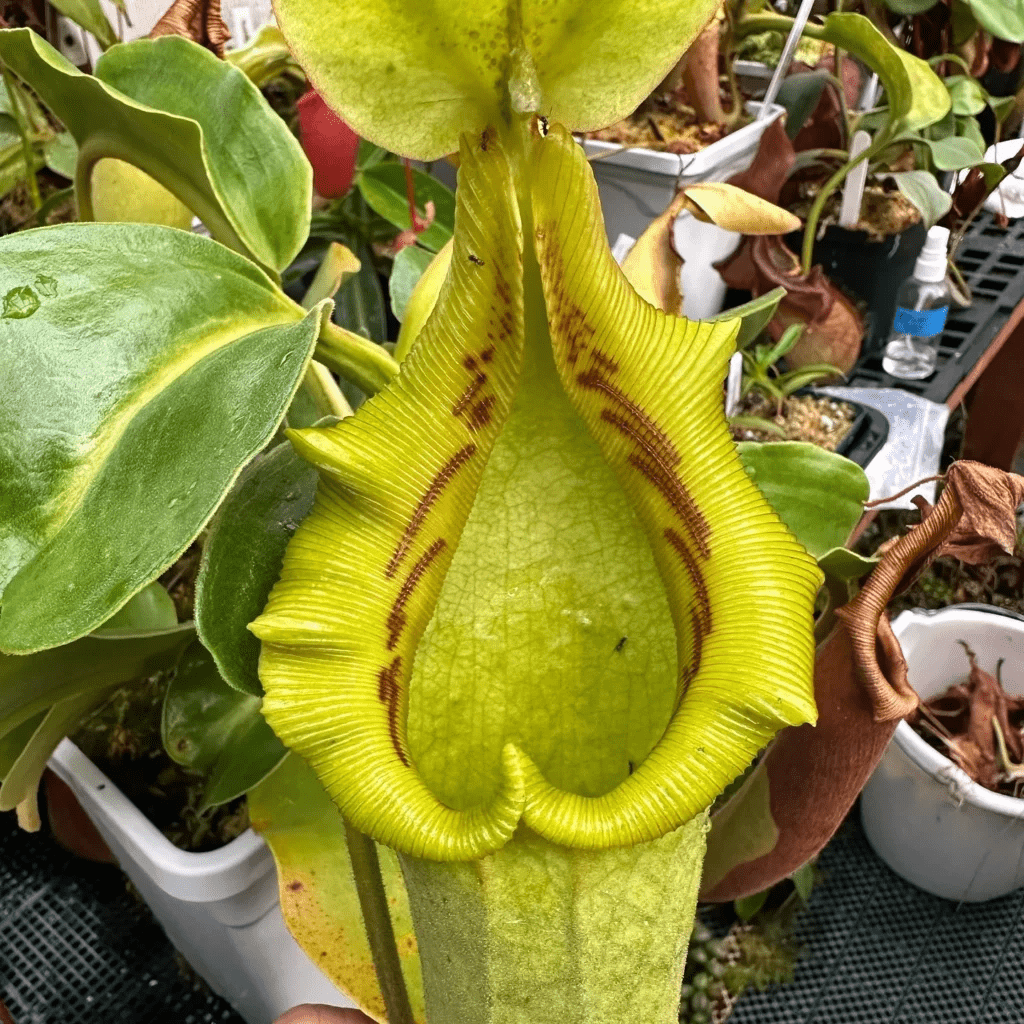
It have hooded pitchers with lid that covers the pitcher opening. The hood shows the shades of green with red.
Attenborough’s pitcher plant (Nepenthes attenboroughii)
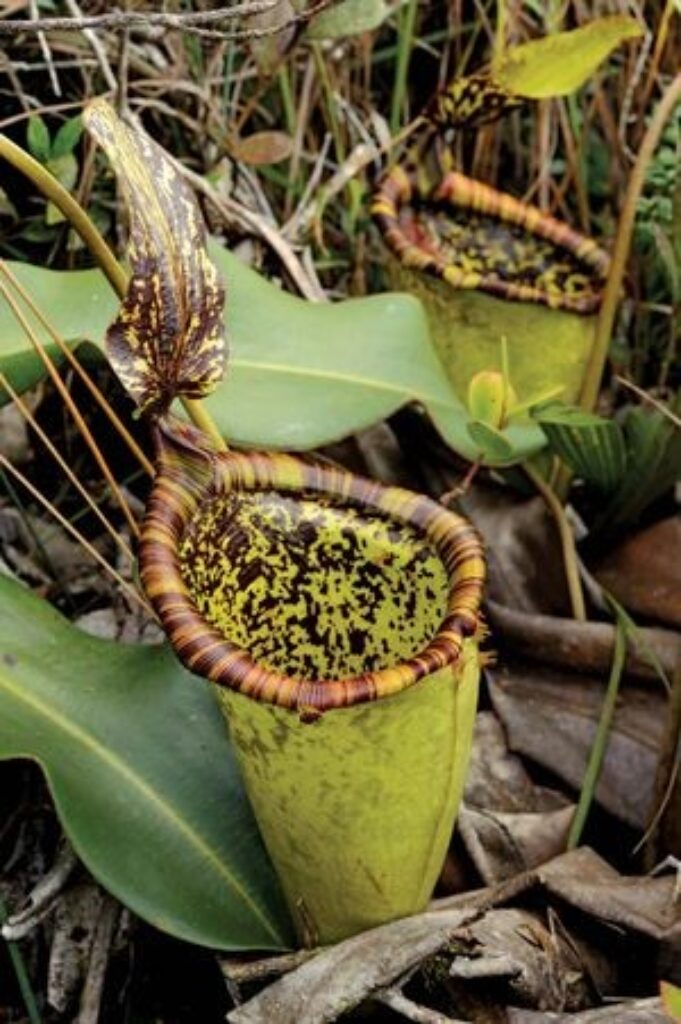
Attenborough’s pitcher plant (Nepenthes attenboroughii), an endangered carnivorous.
Nepenthes bicalcarata
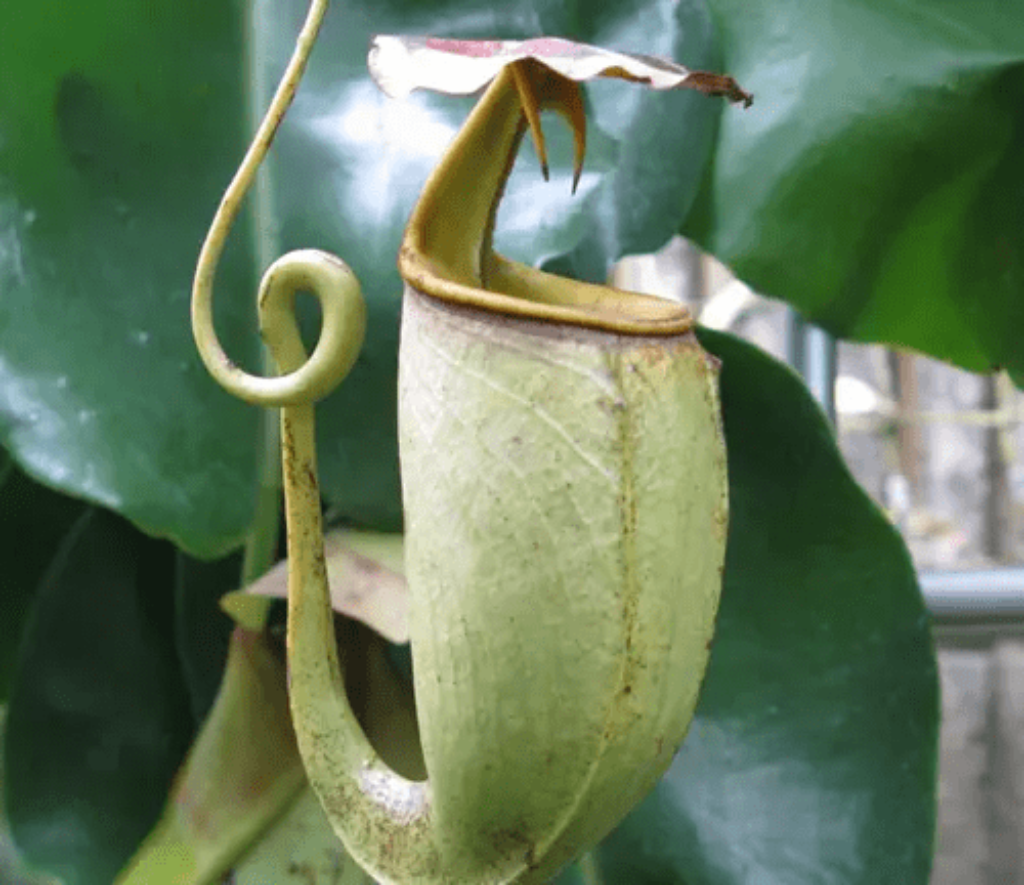
Its most prominent feature is two fang-like structures on the rim of its pitchers.It is found in Borneo.
Nepenthes ventricosa
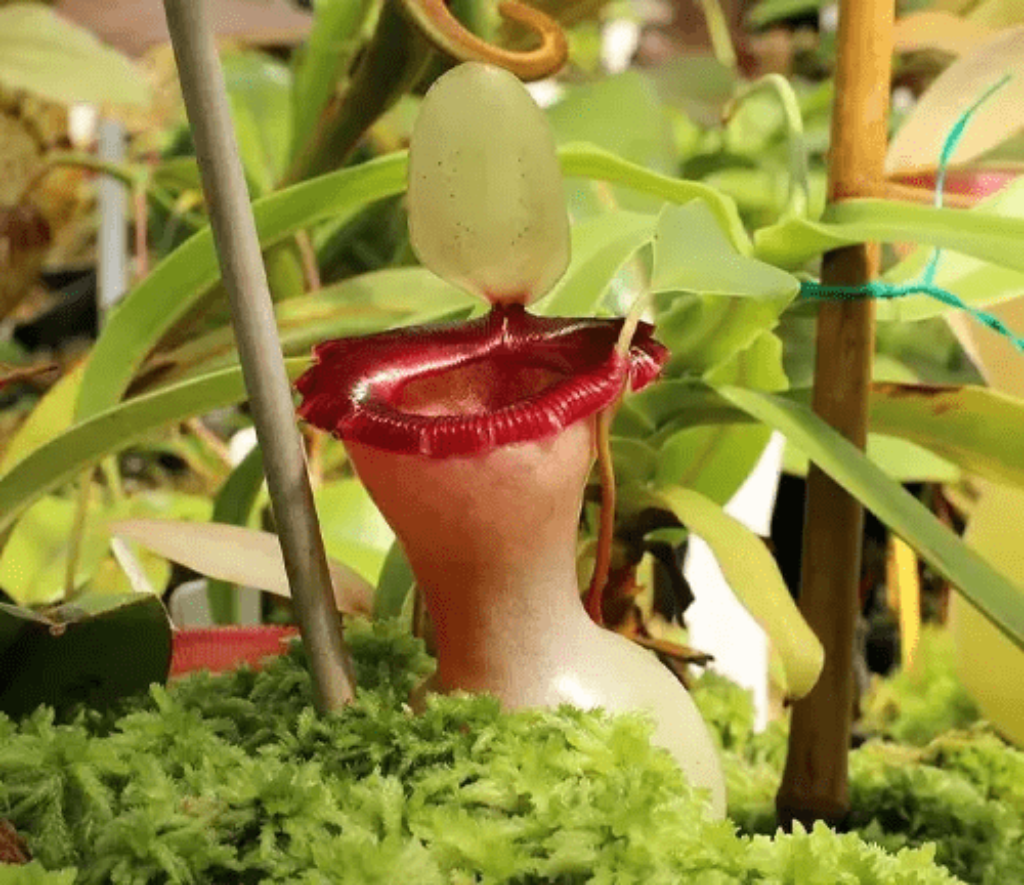
It have rotund pitchers.It is found in Philippines.
Nepenthes alata
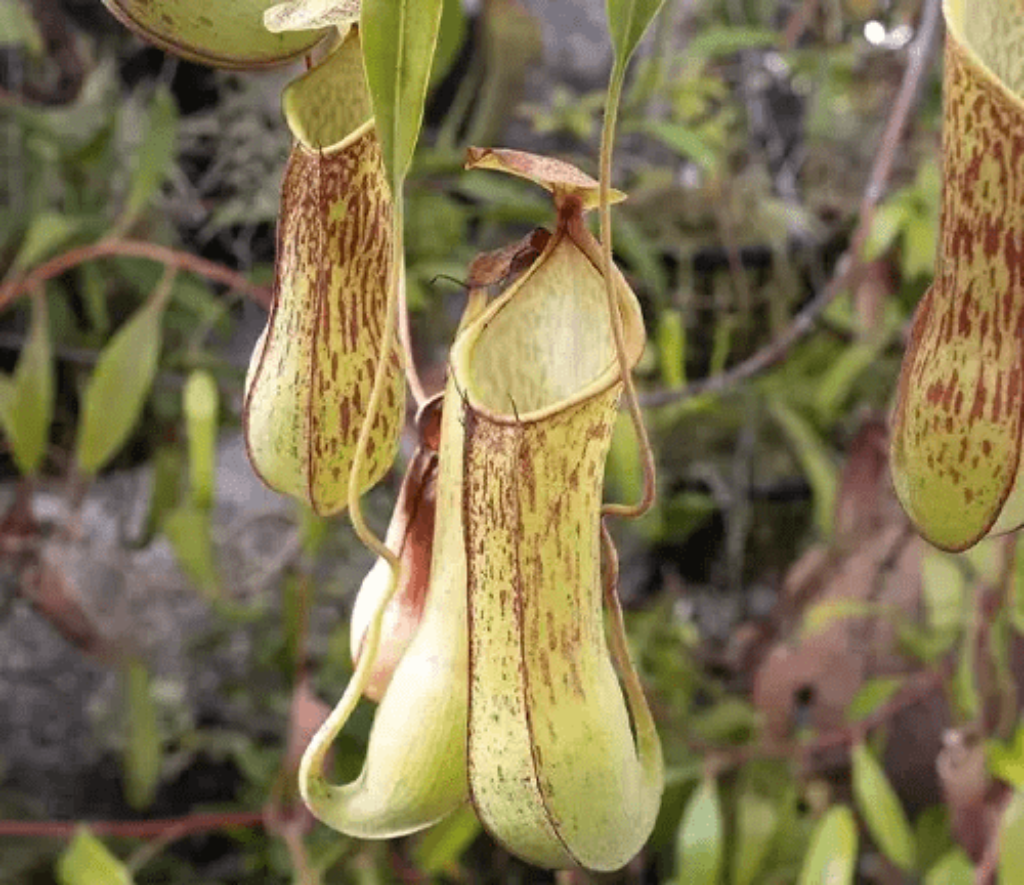
Known for its elegant, narrow pitchers and widespread distribution in Southeast Asia.
Monkey Cup Pitcher Plant (Nepenthes rajah)
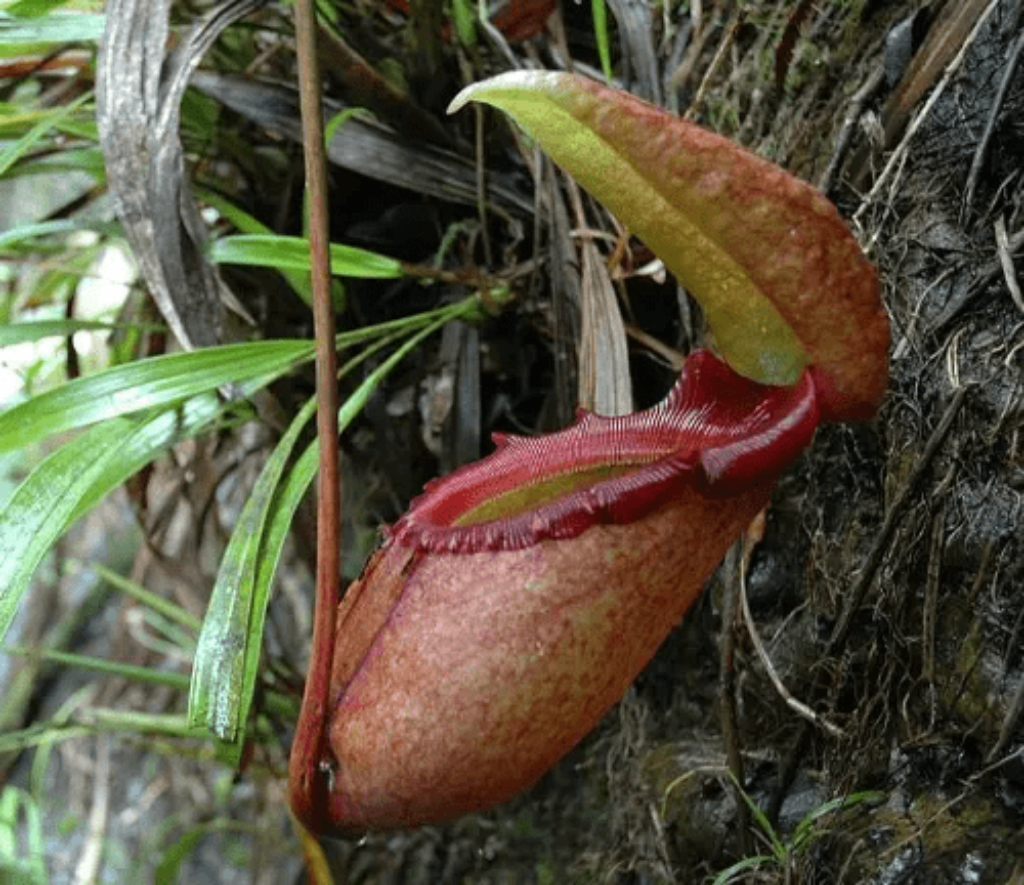
The largest of all Nepenthes species and known for its massive and striking pitchers. It is found in Borneo.
Sarracenia (North American Pitcher Plants)
Red Pitcher Plant (Sarracenia rubra)
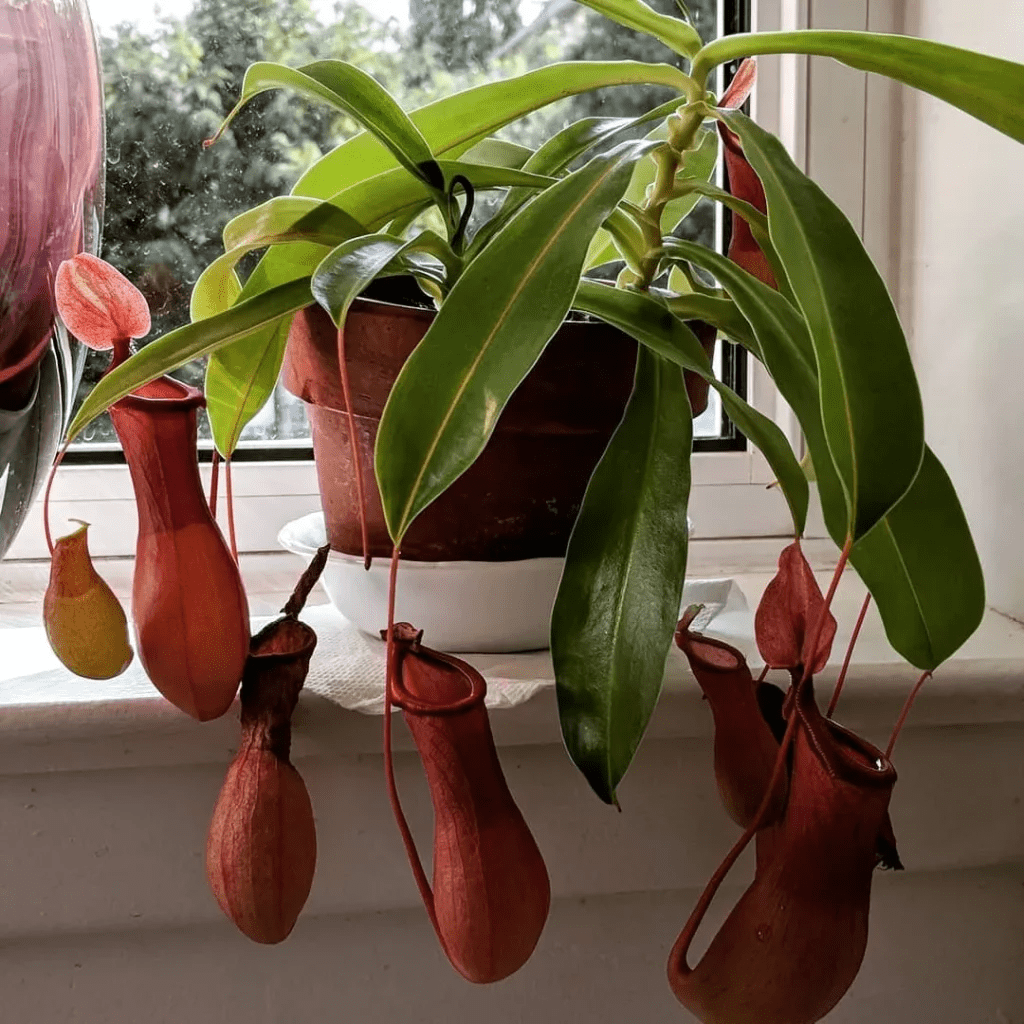
The Red Pitcher Plant have tubular-shaped pitchers that vary in color from deep red to green with red veins. The leaves form tight rosettes, giving it attractive appearance.
The Purple Pitcher Plant (Sarracenia purpurea)
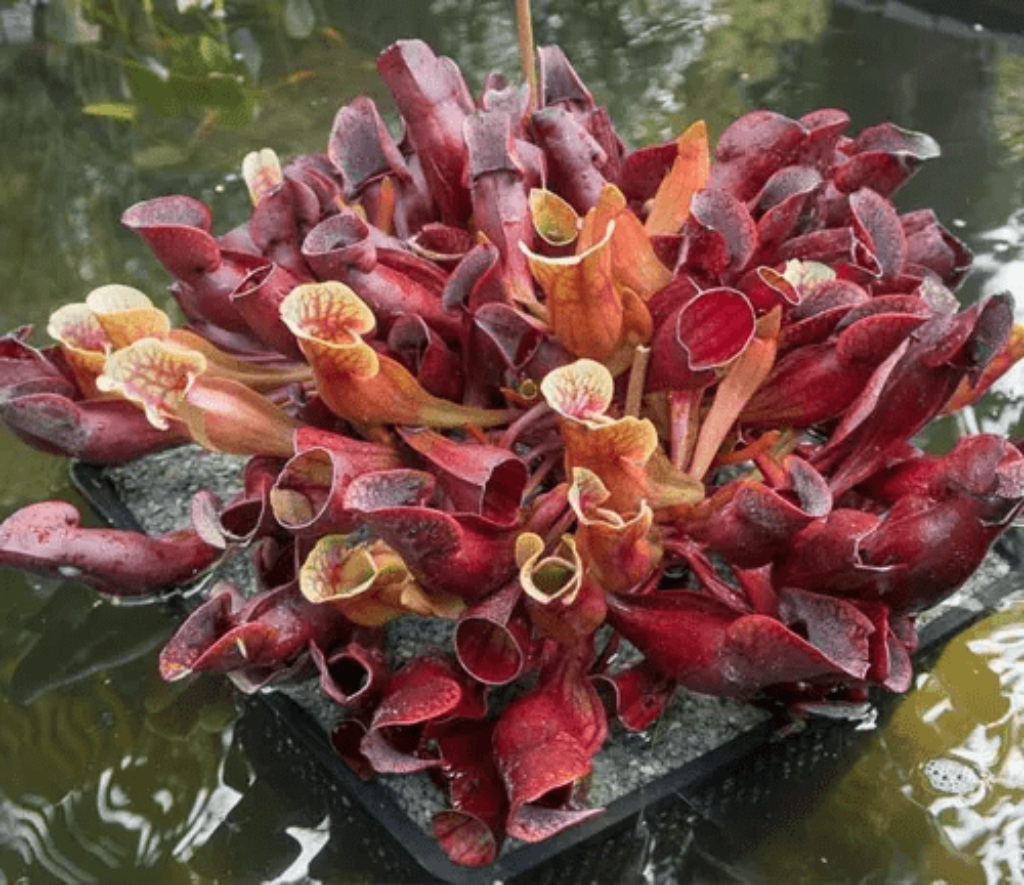
It is found in North America. It have hooded pitchers and show wide range of colors often vibrant shades of purple, especially in bright sunlight. The plan has slender, shape upright leaves with prominent veins.
White Pitcher Plant (Sarracenia leucophylla)
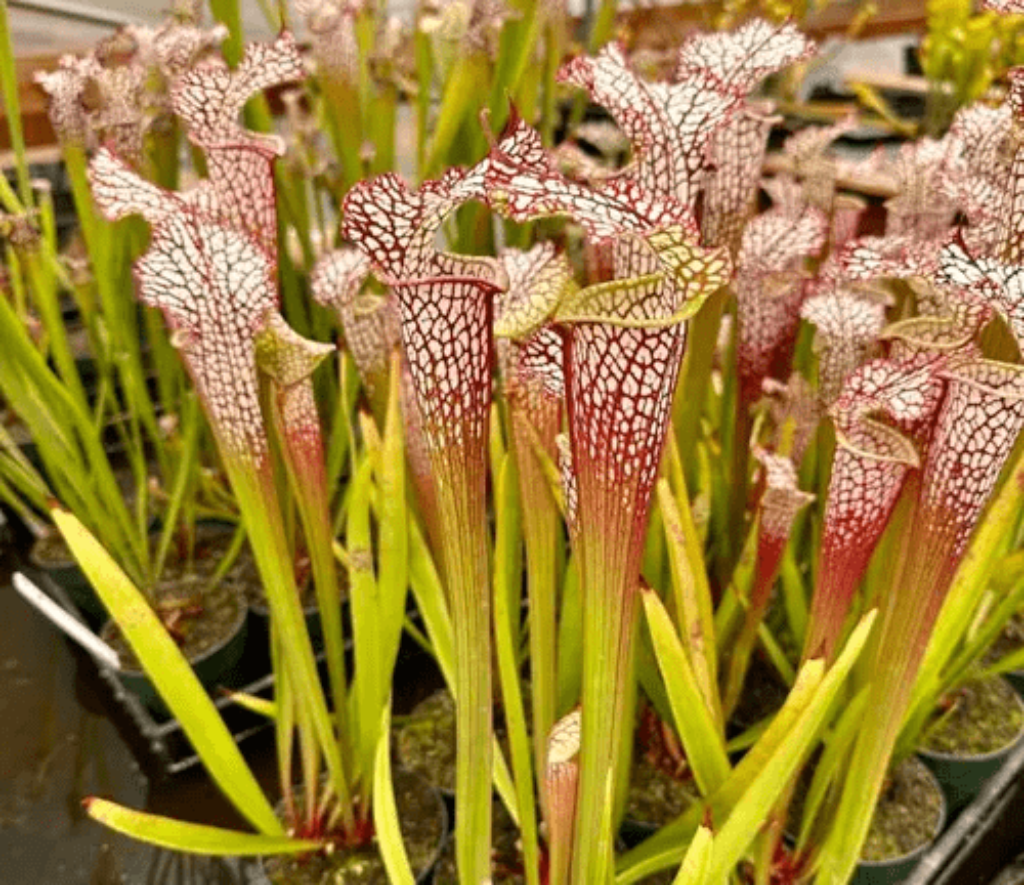
Its pitchers have light green or white colour with red veins. These plants can attain remarkable heights. It is Native to the southeastern United States
Yellow pitcher Plant (Sarracenia flava)
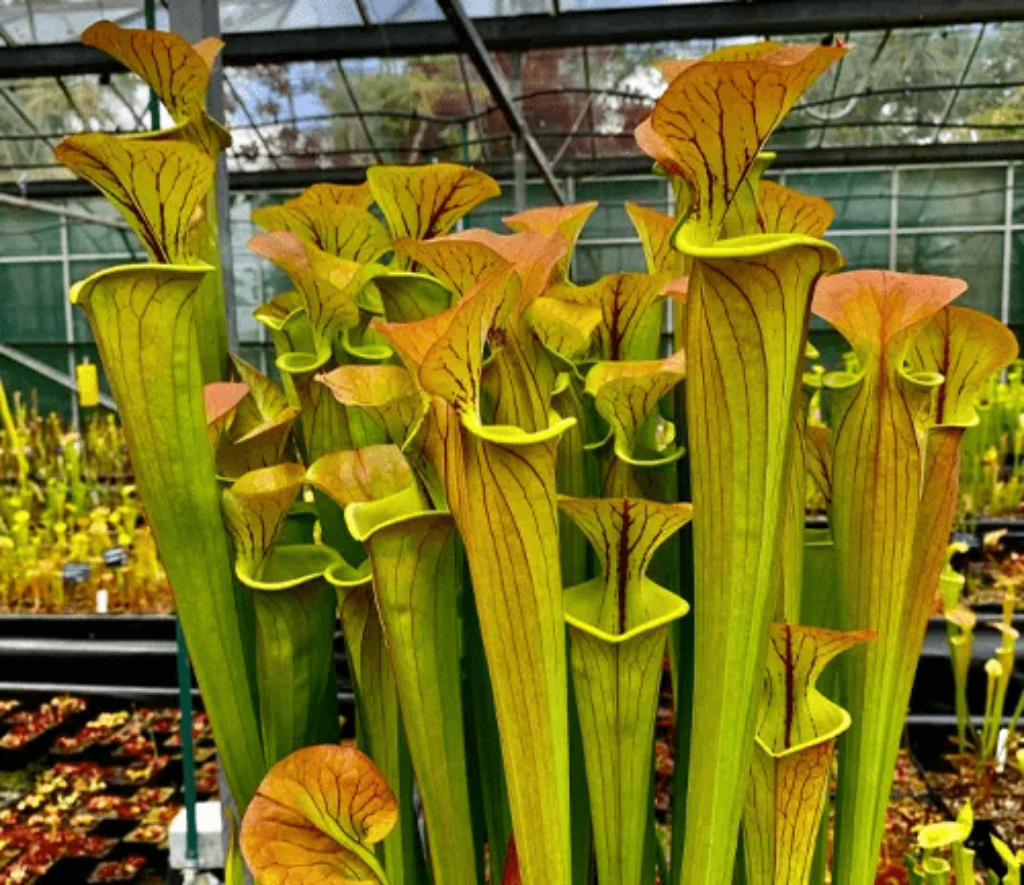
It have bright yellow pitchers.
Helmut/ cobra (Sarracenia minor)
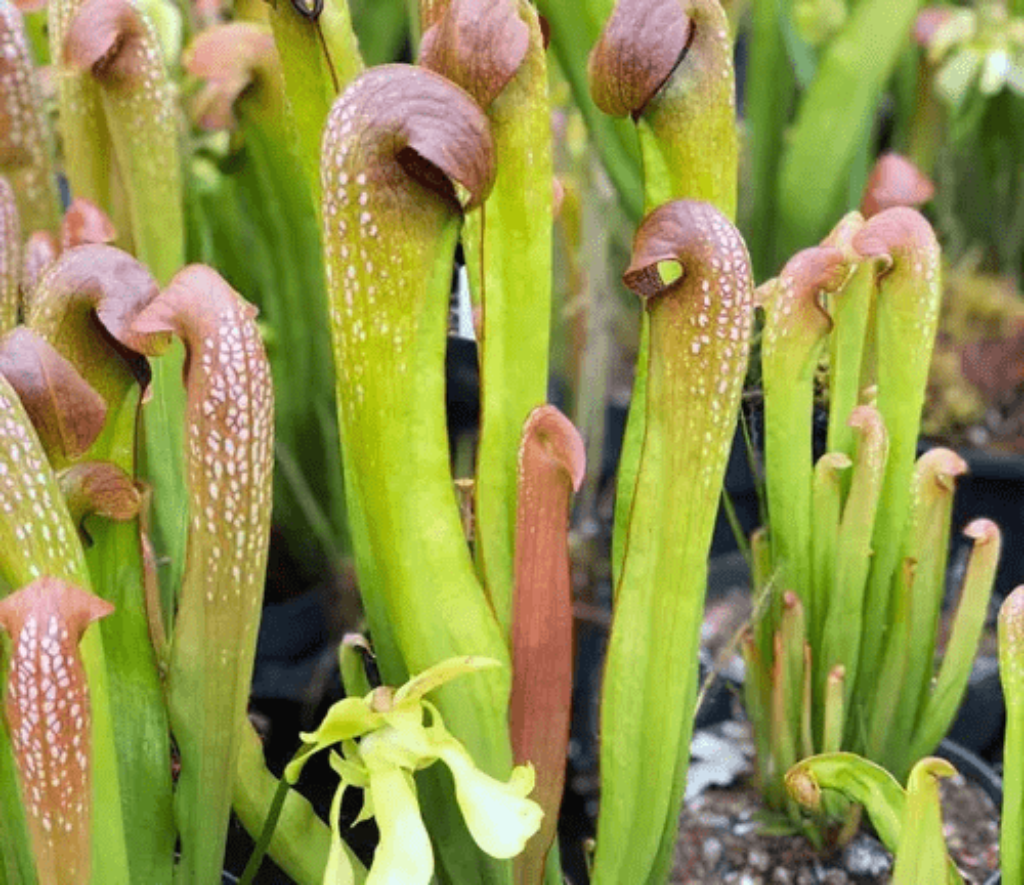
It have a slender and elongated pitchers, with a lid that resembles a helmet. They can be green or reddish in color, with attractive patterning. It is found in the southeastern United States.
The Parrot Pitcher Plant (Sarracenia psittacina)
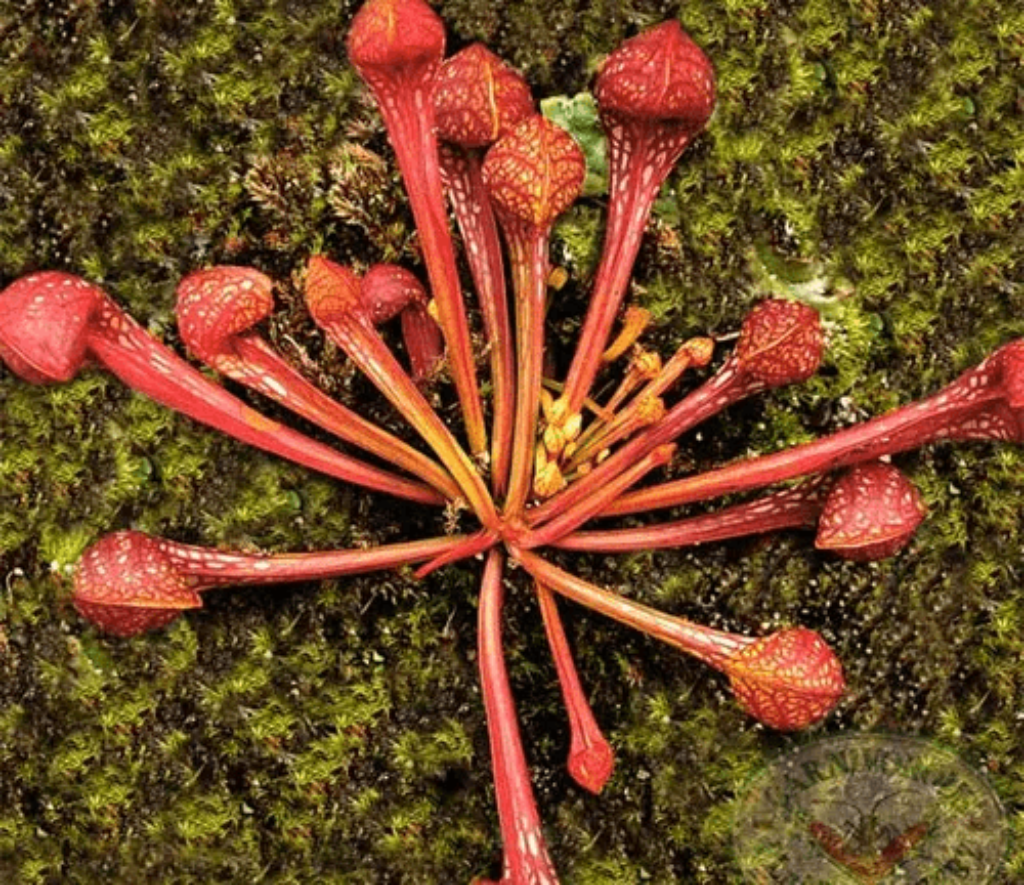
The pitchers of this species are like the beak of a parrot.It is found in the Gulf Coast region.
Sarracenia oreophila
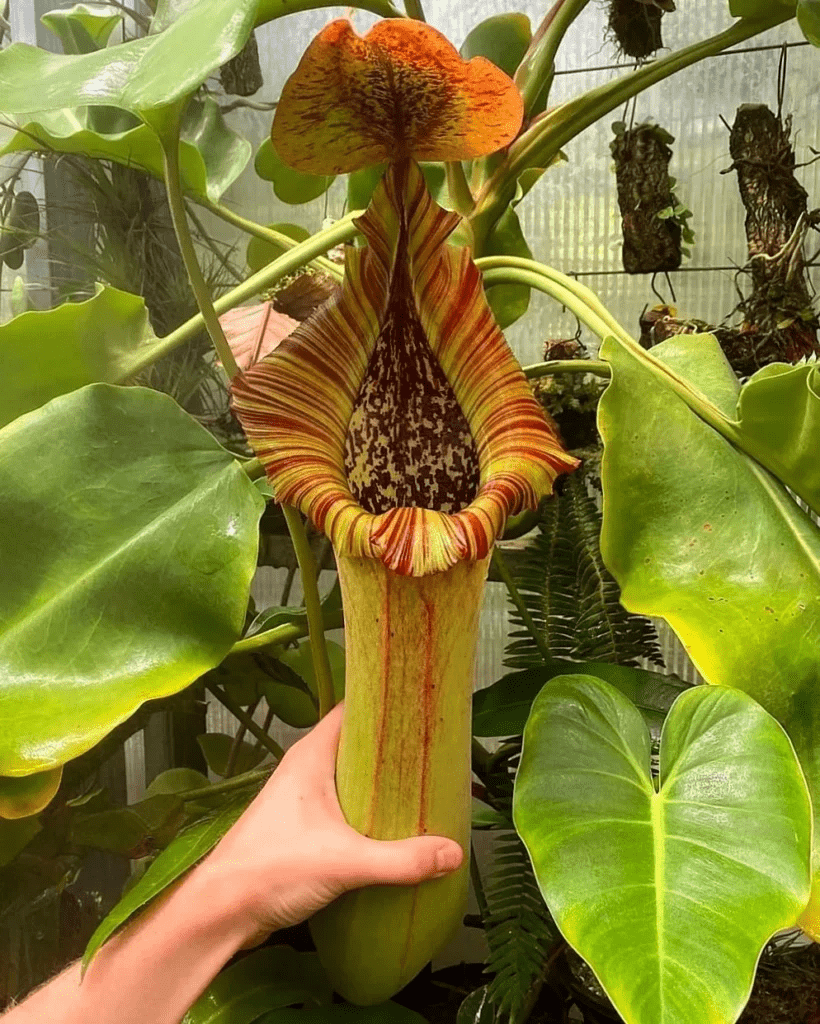
The Giant Pitcher Plant (Sarracenia oreophila) known for its huge height. It might reach 1.5 meter.
Natural Habitats
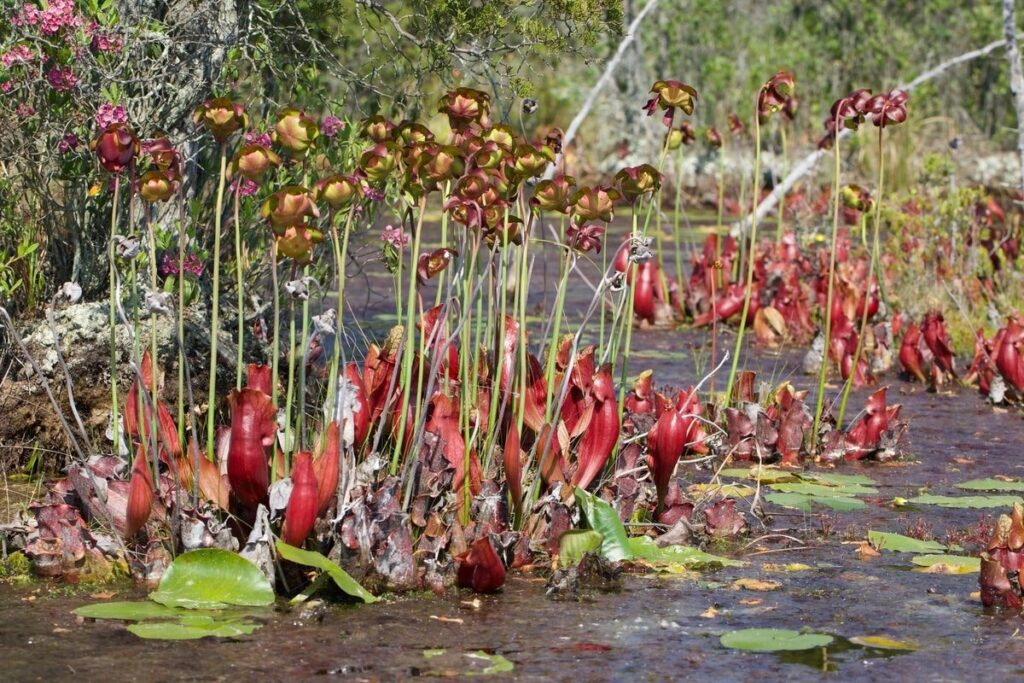
Pitcher plants are distributed across various regions worldwide, including South America, Malaysia, Madagascar, India, and Sri Lanka. These plants thrive in diverse wetland environments such as bogs, meadows, hillside seeps, stream banks, and even roadside ditches. These habitats maintain consistent wet conditions for the majority of the year and usually exhibit substantial subsoil water flow.
These locations Characterized by high humidity, warm temperatures, and nutrient-poor soil, these environmental factors are essential for the successful development of these unique plants.
Commonly known as pitcher plant bogs, these habitats represent one of the most bio-diverse environments within temperate regions. Pitcher plants often grow in dense colonies, forming visually striking landscapes within these wetland areas.
Conservation of pitcher Plant
The habitat of carnivorous plants faces a critical and delicate situation, with various issues contributing to the decline of their ranges. Among these challenges, habitat destruction stands as the foremost concern affecting all flora and fauna globally. While many might associate habitat destruction with the development of new business or residential areas. Here, habitats are being razed to create space for expanded palm or cacao plantations, as well as for subsistence farming.
Given the seemingly endless trajectory of habitat destruction, there’s a pressing need to explore alternative conservation methods. Ex situ conservation, involving the preservation of species outside their natural habitats, emerges as a viable solution. It is essential to establish dedicated organizations committed to the conservation of carnivorous plants to ensure their preservation and protection. These organizations could focus on conserving these unique plants outside their original habitats to safeguard them from the ongoing threats posed by habitat destruction.
Cultural Significance
The Tropical Pitcher Plant holds a distinctive cultural significance beyond its botanical novelty. Originating from the Old World Tropics, it becomes a cultural artifact in regions where it flourishes. Among communities where it is abundant, particularly among the Xhosa people, the Pitcher Plant carries strong medicinal associations. These plants are believed to possess healing properties and are deeply entrenched within local traditions, symbolizing more than just botanical specimens but rather embodying a connection to medicinal beliefs and practices.
The Pitcher Plant often intertwines with spiritual symbolism. During Lunar New Year celebrations, it is regarded as a symbol of prosperity and joy, with the quantity of pitchers symbolizing greater fortune. Similar to the protective symbolism of the Aspidistra in Japan or the sacred connotations of the Ti plant in Hawaii, the Pitcher Plant embodies a connection between nature and spiritual beliefs, reflecting humanity’s tendency to find profound symbolism in the natural world.
Cultivation
How To Grow Pitcher Plant At Home
The pitcher plant can be grown at home. Carefully creating an environment in pots that includes pot filled with rainwater-drained peat and plenty of shade . Keeping it for several hours in direct sunlight mixed with shades and avoid drought is necessary for its growth. With care pitcher plant can reach a significant diameter.
Soil
The pitcher plant has specific soil preferences for optimal growth, stemming from its natural habitats characterized by nutrient-poor conditions, particularly low nitrogen levels. These habitats are typically peat-heavy, creating an acidic pH that suits pitcher plants ideally.
To replicate these natural conditions, the soil should be well-draining to prevent waterlogging, similar to native environments. A commonly used mixture consists of 1 part peat to 1 part perlite, sand, or a similar material.
Direct application of fertilizer to the soil is not good for sensitive plants, as they are adapted to low-nutrient environments. Nepenthes, a species of pitcher plants, thrive in warm temperatures with high humidity. Therefore, it’s essential to ensure that the soil never completely dries out, as this may induce a state of drought for these plants. Regular monitoring of soil moisture is very important for these plants.
Light
Pitcher plants grows best in environments with high humidity and show maximum growth when exposed to six to eight hours of indirect sunlight daily. However, the presence of dense shade from surrounding leaves can reduce their growth. When cultivating pitcher plants in indoor pots, put them in areas with abundant natural light that is similar to their native habitat.
It is important to avoid the drought . Maintaining a delicate balance between light and water. Adequate hydration is necessary for the healthy pitcher plants.
Water
The pitcher plant has specific watering requirements. These plants depend on the natural reservoir of pure rainwater collected in their characteristic pitcher-shaped leaves or traps.
Regular watering is vital to replicate their natural habitat, which typically consists of moist terrains like swamps or areas with peat and leaf litter. Unlike other plants, these carnivorous are intolerant to tap water due to mineral content. They thrive on distilled water or, ideally, rainwater to sustain their delicate structure.
Temperature /humidity
Pitcher plants, particularly Nepenthes, thrive in environments with high humidity and warm temperatures. Hailing from regions such as southeast Asia, Borneo, Madagascar, and Australia, these carnivorous plants necessitate a habitat closely resembling their native climate.
To emulate their natural conditions, maintaining room temperatures between 70-90°F (21-32°C) during the day, with a slight drop at night, is essential. Additionally, sustaining a high humidity level of about 50-70% is also required.
Deviation from these temperature and humidity ranges may induce a state of dormancy in the plant as a protective measure. While a few hours of direct sunlight each day is beneficial, these plants also appreciate some shade to prevent overheating, especially in hotter climates. Striking a balance between light exposure and shade is very important for their optimal growth and health.
Pruning
Pruning a pitcher plant requires understanding of this unique species. Unlike typical plants, the leaves or traps of pitcher plants are not pruned in the traditional sense, as these carnivorous plants rely on their leaves to capture and digest insects.
Instead, focus on the plant’s overall health and selectively remove only the leaves that have turned brown or exhibit signs of disease. It is crucial not to disturb the downward-pointing hairs inside the pitcher, as they play a vital role in trapping insects.
When engaging in pruning, use clean shears or scissors to prevent the introduction of bacteria to the plant. Consider pruning as a method of tidying up the plant rather than a means of promoting growth. Proper pruning practices ensure that your pitcher plant continues to thrive and maintain its unique characteristics.
How to Propagate Pitcher Plant
Pick the Right Spot
Choose a spot that receives indirect sunlight or dappled shade, as these plants benefit from a few hours of direct sunlight each day but can also appreciate some shade to prevent overheating, especially in hot climates.
Select Right pot
When selecting a pot for your pitcher plant, it’s crucial to choose one that accommodates the plant’s unique growth characteristics. Choose pot that can support the spread of the pitcher plant’s leaves, and plant’s diameter. This allows ample space for the plant to develop and thrive.
Moreover pot should has good drainage. Pitcher plants prefer damp conditions but are averse to waterlogged soil, as this can lead to root rot. Adequate drainage helps maintain the right balance of moisture for the plant’s health.
Appropriate size and drainage provide the proper growth of your pitcher plant.
To Prepare a Suitable Planting Mix for Your Pitcher Plant
- Use high-quality sphagnum peat moss as the primary component of your mix.
- Consider adding perlite or sand to enhance drainage and aeration.
Combine equal parts peat moss and perlite or sand in a clean container.
Planting the Pitcher
Nestle it gently in the prepared mix, ensuring not to damage the leaves or developing traps.
Insect Feeding: Occasionally provide your pitcher plant with insect feeds, especially during periods of drought when insect availability might be limited. This mimics its natural diet and,supports its nutritional needs.
Watering with Rainwater: Use rainwater instead of tap water for watering. Rainwater is preferred because some tap water contains chlorine, which can be harmful to the plant. Maintain the soil consistently moist but not waterlogged.
Sunlight and Shade Balance: Monitor the balance of sunlight and shade. While pitcher plants benefit from a few hours of direct sunlight each day, they also appreciate some shade to prevent overheating, especially in warmer climates.
Stable Climate: Maintain a stable climate with temperatures ranging from 70-90°F (21-32°C) during the day and a slight drop at night. This emulates the tropical conditions to which pitcher plants are accustomed.
Avoid Extreme Conditions: Protect the plant from extreme conditions, both in terms of temperature and humidity. Pitcher plants may enter a state of dormancy if conditions deviate too far from their preferred ranges.
Watch Out for Traps and Lids: As your pitcher plant grows, pay close attention to the development of traps with a lid. This lid plays a crucial role as it triggers downward-pointing hairs, guiding the prey toward the bacteria residing at the bottom of the trap. This collaboration aids in the digestion process of captured insects.
Monitoring the diameter of the traps can provide insights into the overall health and thriving status of your plant. A robust and thriving pitcher plant will often exhibit well-formed and adequately sized traps, reflecting its successful adaptation to its environment and its effectiveness in capturing and digesting prey.
Where to Buy Pitcher Plants
You can grow carnivorous plants in your own home.However, it’s essential to note that certain species of these plants have been excessively harvested to the brink of near extinction.Cultivating carnivorous plants in your home is achievable by purchasing them from authorized and reputable growers. In North Carolina, for instance, the illegal poaching of Venus flytraps became a significant issue.
How to Chose Pitcher Plant According to your location
No matter your climate, there are various choices for beautiful bog plants to complement your carnivorous plants.
It’s crucial to obtain carnivorous plants only from reputable nurseries and dealers. The poaching of wild carnivorous plants poses a significant threat to the survival of these extraordinary botanical wonders.
Once you’ve chosen and acquired your plants, carefully consider their placement. If your mini-bog is visible from all sides, plant the tallest species towards the center and terrace down to shorter plants. If the view is primarily from one side, position the tallest species at the back and arrange shorter plants towards the front. This thoughtful arrangement enhances the visual appeal of your bog garden.
Common Problems of pitcher plant and its Solutions
Yellowing Leaves: Yellowing leaves may indicate nutrient absorption issues. Apply a peat-based fertilizer at the base of the plant and monitor leaf health regularly.
Insects – Scale Insects: Scale insects are common pests that can deplete nutrients and cause yellowing and dropping of leaves. Inspect the plant, especially the underside of leaves and traps, for signs of these pests.
Thrips: Thrips feed on nectar and prey within traps, depriving the plant of nitrogen. Look for black droppings on leaves as a sign of thrips and take appropriate measures.
Botrytis (Grey Mold): Grey mold can affect pitcher plants, especially in humid climates. Ensure proper air circulation around the plants to prevent Botrytis.
Fungal Diseases: Hygiene and good airflow to prevent fungal diseases, common in the high humidity and warm temperatures of their native habitats.
Chlorosis: Chlorosis, causing yellowing leaves, is often due to nutrient deficiencies. Use a balanced fertilizer and regularly feed the plant insects to prevent this disease.
Brown Tips:Brown tips can result from insufficient water or low humidity. Water with rainwater, avoid tap water, provide shade, and limit direct sunlight to address this issue.
Small Traps: Malnutrition can lead to small traps. Monitor nitrogen levels and ensure the plant receives sufficient nutrients for proper growth.
Pitcher Drop-Off: If there is a decrease in the number of pitchers, it may indicate a lack of prey. Place the plant in a location where it is likely to capture more insects.
Failure to Capture Prey: Ensure the downward-pointing hairs within the pitcher traps are functional. Check the trap lid and maintain proper moisture levels inside the pitcher to aid in prey capture.
Regular monitoring, proper care, and prompt action can help address these issues and ensure the well-being of your Pitcher Plants.
How to Grow Mini-Bogs at home
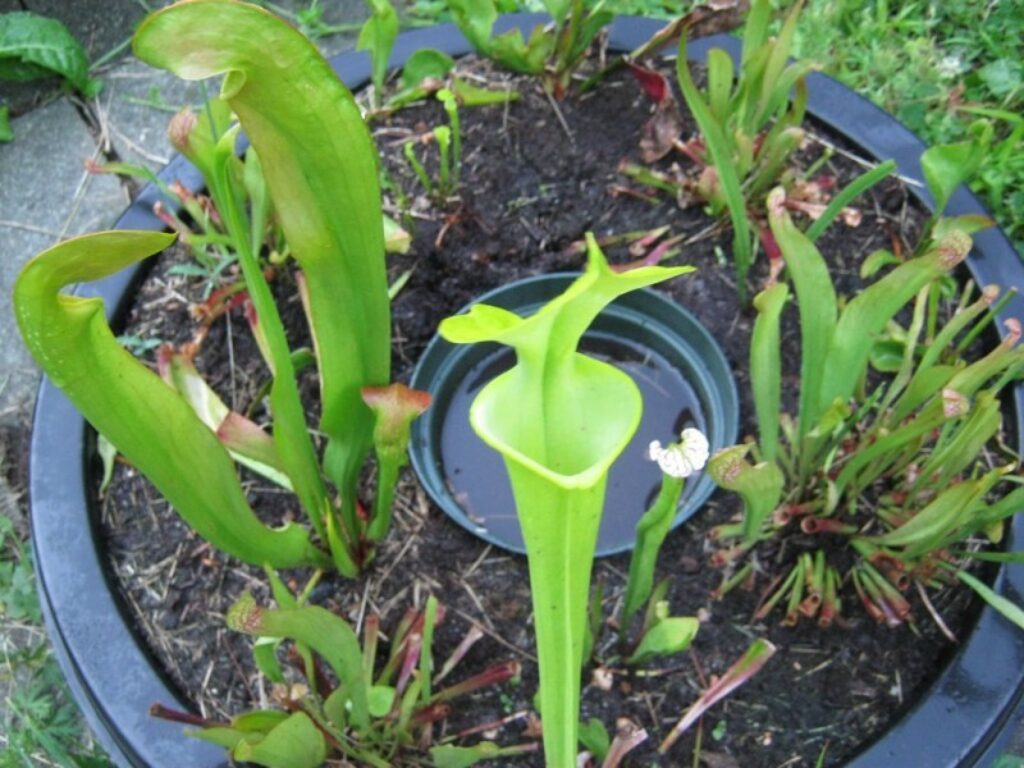
Similar to the natural environment of carnivorous plants in the wild, which typically involves sunny, acidic, nutrient-poor wetlands known as bogs, can be achieved by home gardeners in a mini-bog planter. This allows for the cultivation of a diverse range of carnivorous plant species, including sundews, pitcher plants, and butterworts. Additionally, incorporating orchids and other noncarnivorous wetland plants can contribute to creating a captivating miniature habitat.
The mini-bog planter eliminates the need for hand-feeding carnivorous plants, as insects are naturally drawn to the environment. Houseflies and wasps, among other insects, are likely to become prey for carnivorous plants like flytraps and pitcher plants, enhancing the interactive and fascinating nature of the miniature ecosystem.
How to chose Pot for Mini Bog
Carnivorous plants, such as pitcher plants, can flourish in a straightforward container. Here are instructions for constructing a mini-bog using a basic pond liner from a home-improvement store, but the idea can be adapted to various containers. Almost any plastic or metal container without drainage holes can be utilized to replicate boggy conditions, ranging from a window box or flowerpot to unconventional vessels like a salad bowl, tool box, or even an old rain boot. It’s essential to plan to keep your mini-bog container outdoors in a sunny location for most of the year. This setup allows you to create a suitable environment for carnivorous plants to thrive, mimicking their natural habitat.
Here are step-by-step instructions for constructing a mini-bog:
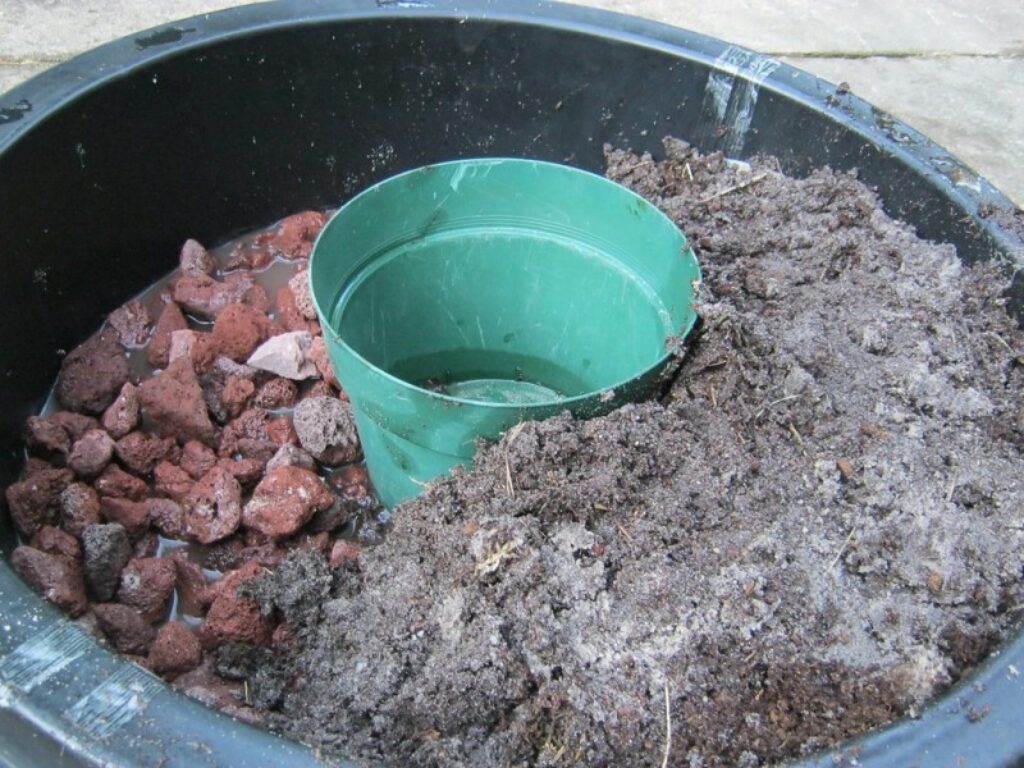
Step 1: Fill the bottom two inches of the pond liner with crushed lava rock to create a water space.
Step 2: Place a plastic nursery pot in the center of the pond liner. Keep this pot empty and fill the surrounding space with soil. This pot will serve as a reservoir for bottom-watering your plants, reducing the need for top watering.
Step 3: Create a growing medium by combining 50% sphagnum peat moss, 30% horticultural sand, and 20% long-fiber sphagnum moss. Saturate the mix with water until it reaches a mud-like consistency. Fill the planter (outside the plastic pot) with this soil mix.
Step 4: Design your mini-bog with varying levels to enhance visual appeal. You can plant lower areas with flood-tolerant species like spoonleaf sundew and parrot pitcher plant, while higher areas can be planted with less flood-tolerant species like Venus flytrap.
Step 5: Choose a mix of carnivorous plants and other bog-loving species based on your climate zone. Consider cold hardiness, focusing on Venus flytraps, American pitcher plants, temperate and warm-temperate sundews, and butterworts. Adjust plant choices based on your specific climate zone.
Step 6: Top dress your mini-bog with materials like pine needles, pine bark, quartz stone, or live sphagnum to add realism and protect plants from heavy rain. This top dressing may also deter squirrels and birds.
By following these steps, you can create a thriving mini-bog that replicates the conditions needed for carnivorous plants to flourish in a home garden.
Care Instructions for Mini-Bog
Watering: Water quality is crucial for carnivorous plants. Use distilled water, reverse osmosis water, or rainwater to irrigate your mini-bog. If your tap water has more than 100 parts per million dissolved solids or a pH higher than 8, avoid using it. When watering, fill the reservoir pot to the top, allowing the water level to drop over a few days to facilitate oxygen permeation in the soil. If your mini-bog experiences constant flooding in very rainy regions, consider drilling drainage holes about an inch below the soil surface.
Light: Position your mini-bog in a location where it receives at least five to six hours of direct, unobstructed sunlight. Adequate sunlight is essential for the health and growth of carnivorous plants.
Overwintering: Many carnivorous plants native to the United States require a winter dormancy period. If you are growing non-winter-hardy plants, provide shelter during winter while allowing for natural dormancy. As freezing temperatures approach, move the mini-bog to a sunny glassed-in porch or a windowed basement to maintain cool conditions while protecting the plants. Alternatively, if you choose to leave the mini-bog outside, bury the pond liner to ground level and mulch the top with two to three inches of pine needles or straw to insulate and protect the plants during winter.
Conclusion
ones can cultivate carnivorous plants in a controlled and captivating environment. By replicating the conditions of nutrient-poor wetlands like you can observe these unique plants flourish while mimicking their natural habitat.
Key considerations for successful cultivation include the choice of an appropriate container, the composition of a suitable growing medium, and the careful selection of carnivorous plants based on your climate zone. Constructing a reservoir pot for bottom-watering reduces the need for frequent watering and contributes to the overall health of the plants.
Remember to prioritize water quality, using distilled water, reverse osmosis water, or rainwater to avoid potential harm from tap water impurities. Adequate sunlight is crucial, so position your mini-bog where it can receive at least five to six hours of direct sunlight daily.
